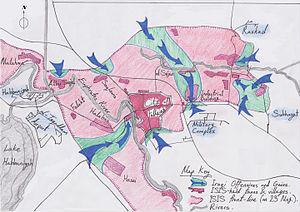Battle for MosulMosul will fall – but it may take a bigger U.S. presence to force Islamic State out
The 5,000 ISIS paramilitaries deployed to defend Mosul will eventually lose to the 60,000-strong coalition forces arrayed against them. But a defeat in Mosul, or even in Raqqa, may not finish ISIS off. As IS moves away from being fixated on its caliphate, it is now embarking on more of a virtual existence – recruiting across the world with a focus on Western countries. And even if ISIS is in decline, what is happening in parallel is the rebirth of groups linked formally or informally to al-Qaeda which has reinvented itself as a less extreme entity that pays greater deference to local cultures and is promoting this in marked contrast to the sheer brutality of ISIS.

Iraq hopes to emulate successful Fallujah operation // Source: wikipedia.org
As the operation to defeat Islamic State in Mosul moves into its fourth week, Iraqi Army forces are making singularly slow progress towards the city, principally from the east and north – with the town of Bashiqa, beyond the city’s outer suburbs, a current focus.
IS tactics have so far been mainly to avoid direct confrontation while setting up what the most senior U.S. commander in the operation, Lieutenant-General Stephen Townsend, calls an “external disruption zone” – using a wide array of indirect fire attacks, suicide bombers and snipers.
There have been exceptions – IS released a video of an apparently successful attack on an M1A1 Abrams main battle tank and an entirely unexpected but substantial attack on government offices in Kirkuk. There are also fears that IS will access industrial chemicals such as chlorine gas to stage crude chemical attacks – so much so that coalition sources supplied 24,000 respirators to Iraqi forces before the operation started.
IS is reported to have around 5,000 paramilitaries deployed for the defense of Mosul – and one of the major questions has been what its tactics will be: meeting their foes head-on in battle or going to ground to fight using long-term guerrilla tactics. Although the main towns and cities in Anbar Province, such as Ramadi and Fallujah, have been taken by government forces, IS remains active across the province, helped by Sunni antagonism to the government reliance on Shia militias.
The indications are that IS will stay and fight – conscious that while it faces perhaps more than 60,000 troops, it is a very complex and disparate coalition. At the core are Iraqi special forces, fronting much less well-trained regular Iraqi Army units. In addition there are Iraqi Shia militias, Iranian Revolutionary Guard elements, Kurdish Peshmerga forces, Turkish Army units, American, French, British, and possibly Australian special forces, American and French combat troops, and scores of strike aircraft and helicopter gunships.
